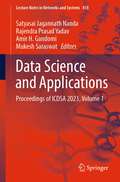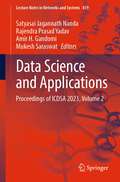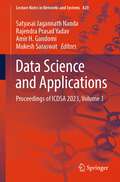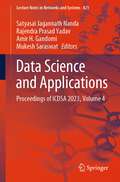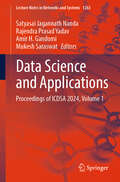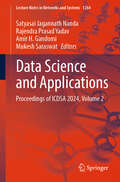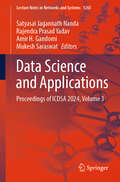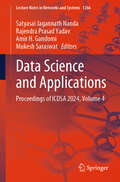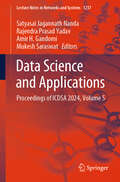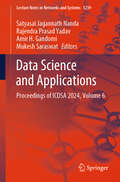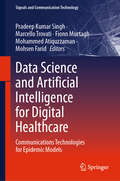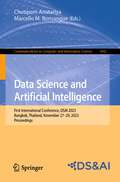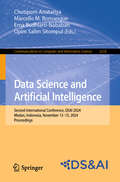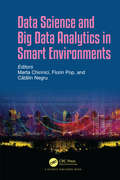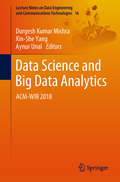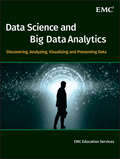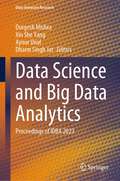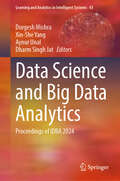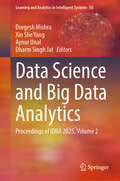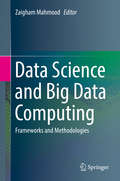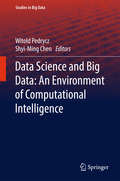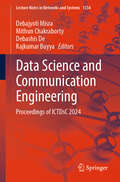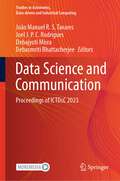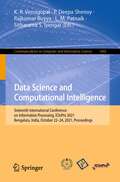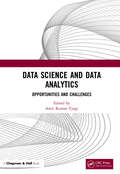- Table View
- List View
Data Science and Applications: Proceedings of ICDSA 2023, Volume 1 (Lecture Notes in Networks and Systems #818)
by Amir H. Gandomi Mukesh Saraswat Rajendra Prasad Yadav Satyasai Jagannath NandaThis book gathers outstanding papers presented at the International Conference on Data Science and Applications (ICDSA 2023), organized by Soft Computing Research Society (SCRS) and Malaviya National Institute of Technology Jaipur, India, from 14 to 15 July 2023. The book is divided into four volumes, and it covers theoretical and empirical developments in various areas of big data analytics, big data technologies, decision tree learning, wireless communication, wireless sensor networking, bioinformatics and systems, artificial neural networks, deep learning, genetic algorithms, data mining, fuzzy logic, optimization algorithms, image processing, computational intelligence in civil engineering, and creative computing.
Data Science and Applications: Proceedings of ICDSA 2023, Volume 2 (Lecture Notes in Networks and Systems #819)
by Amir H. Gandomi Mukesh Saraswat Rajendra Prasad Yadav Satyasai Jagannath NandaThis book gathers outstanding papers presented at the International Conference on Data Science and Applications (ICDSA 2023), organized by Soft Computing Research Society (SCRS) and Malaviya National Institute of Technology Jaipur, India, from 14 to 15 July 2023. The book is divided into four volumes, and it covers theoretical and empirical developments in various areas of big data analytics, big data technologies, decision tree learning, wireless communication, wireless sensor networking, bioinformatics and systems, artificial neural networks, deep learning, genetic algorithms, data mining, fuzzy logic, optimization algorithms, image processing, computational intelligence in civil engineering, and creative computing.
Data Science and Applications: Proceedings of ICDSA 2023, Volume 3 (Lecture Notes in Networks and Systems #820)
by Amir H. Gandomi Mukesh Saraswat Rajendra Prasad Yadav Satyasai Jagannath NandaThis book gathers outstanding papers presented at the International Conference on Data Science and Applications (ICDSA 2023), organized by Soft Computing Research Society (SCRS) and Malaviya National Institute of Technology Jaipur, India, from 14 to 15 July 2023. The book is divided into four volumes, and it covers theoretical and empirical developments in various areas of big data analytics, big data technologies, decision tree learning, wireless communication, wireless sensor networking, bioinformatics and systems, artificial neural networks, deep learning, genetic algorithms, data mining, fuzzy logic, optimization algorithms, image processing, computational intelligence in civil engineering, and creative computing.
Data Science and Applications: Proceedings of ICDSA 2023, Volume 4 (Lecture Notes in Networks and Systems #821)
by Amir H. Gandomi Mukesh Saraswat Rajendra Prasad Yadav Satyasai Jagannath NandaThis book gathers outstanding papers presented at the International Conference on Data Science and Applications (ICDSA 2023), organized by Soft Computing Research Society (SCRS) and Malaviya National Institute of Technology Jaipur, India, from 14 to 15 July 2023. The book is divided into four volumes, and it covers theoretical and empirical developments in various areas of big data analytics, big data technologies, decision tree learning, wireless communication, wireless sensor networking, bioinformatics and systems, artificial neural networks, deep learning, genetic algorithms, data mining, fuzzy logic, optimization algorithms, image processing, computational intelligence in civil engineering, and creative computing.
Data Science and Applications: Proceedings of ICDSA 2024, Volume 1 (Lecture Notes in Networks and Systems #1263)
by Amir H. Gandomi Mukesh Saraswat Rajendra Prasad Yadav Satyasai Jagannath NandaThis book gathers outstanding papers presented at the 5th International Conference on Data Science and Applications (ICDSA 2024), organized by Soft Computing Research Society (SCRS) and Malaviya National Institute of Technology Jaipur, India, from July 17 to 19, 2024. The book is divided into four volumes, and it covers theoretical and empirical developments in various areas of big data analytics, big data technologies, decision tree learning, wireless communication, wireless sensor networking, bioinformatics and systems, artificial neural networks, deep learning, genetic algorithms, data mining, fuzzy logic, optimization algorithms, image processing, computational intelligence in civil engineering, and creative computing.
Data Science and Applications: Proceedings of ICDSA 2024, Volume 2 (Lecture Notes in Networks and Systems #1264)
by Amir H. Gandomi Mukesh Saraswat Rajendra Prasad Yadav Satyasai Jagannath NandaThis book gathers outstanding papers presented at the 5th International Conference on Data Science and Applications (ICDSA 2024), organized by Soft Computing Research Society (SCRS) and Malaviya National Institute of Technology Jaipur, India, from 17 to 19 July 2024. The book is divided into four volumes, and it covers theoretical and empirical developments in various areas of big data analytics, big data technologies, decision tree learning, wireless communication, wireless sensor networking, bioinformatics and systems, artificial neural networks, deep learning, genetic algorithms, data mining, fuzzy logic, optimization algorithms, image processing, computational intelligence in civil engineering, and creative computing.
Data Science and Applications: Proceedings of ICDSA 2024, Volume 3 (Lecture Notes in Networks and Systems #1265)
by Amir H. Gandomi Mukesh Saraswat Rajendra Prasad Yadav Satyasai Jagannath NandaThis book gathers outstanding papers presented at the 5th International Conference on Data Science and Applications (ICDSA 2024), organized by Soft Computing Research Society (SCRS) and Malaviya National Institute of Technology Jaipur, India, from July 17 to 19, 2024. The book is divided into four volumes, and it covers theoretical and empirical developments in various areas of big data analytics, big data technologies, decision tree learning, wireless communication, wireless sensor networking, bioinformatics and systems, artificial neural networks, deep learning, genetic algorithms, data mining, fuzzy logic, optimization algorithms, image processing, computational intelligence in civil engineering, and creative computing.
Data Science and Applications: Proceedings of ICDSA 2024, Volume 4 (Lecture Notes in Networks and Systems #1266)
by Amir H. Gandomi Mukesh Saraswat Rajendra Prasad Yadav Satyasai Jagannath NandaThis book gathers outstanding papers presented at the 5th International Conference on Data Science and Applications (ICDSA 2024), organized by Soft Computing Research Society (SCRS) and Malaviya National Institute of Technology Jaipur, India, from July 17 to 19, 2024. The book is divided into four volumes, and it covers theoretical and empirical developments in various areas of big data analytics, big data technologies, decision tree learning, wireless communication, wireless sensor networking, bioinformatics and systems, artificial neural networks, deep learning, genetic algorithms, data mining, fuzzy logic, optimization algorithms, image processing, computational intelligence in civil engineering, and creative computing.
Data Science and Applications: Proceedings of ICDSA 2024, Volume 5 (Lecture Notes in Networks and Systems #1237)
by Amir H. Gandomi Mukesh Saraswat Rajendra Prasad Yadav Satyasai Jagannath NandaThis book gathers outstanding papers presented at the 5th International Conference on Data Science and Applications (ICDSA 2024), organized by Soft Computing Research Society (SCRS) and Malaviya National Institute of Technology Jaipur, India, from 17 to 19 July 2024. The book is divided into four volumes, and it covers theoretical and empirical developments in various areas of big data analytics, big data technologies, decision tree learning, wireless communication, wireless sensor networking, bioinformatics and systems, artificial neural networks, deep learning, genetic algorithms, data mining, fuzzy logic, optimization algorithms, image processing, computational intelligence in civil engineering, and creative computing.
Data Science and Applications: Proceedings of ICDSA 2024, Volume 6 (Lecture Notes in Networks and Systems #1239)
by Amir H. Gandomi Mukesh Saraswat Rajendra Prasad Yadav Satyasai Jagannath NandaThis book gathers outstanding papers presented at the 5th International Conference on Data Science and Applications (ICDSA 2024), organized by Soft Computing Research Society (SCRS) and Malaviya National Institute of Technology Jaipur, India, from 17 to 19 July 2024. The book is divided into four volumes, and it covers theoretical and empirical developments in various areas of big data analytics, big data technologies, decision tree learning, wireless communication, wireless sensor networking, bioinformatics and systems, artificial neural networks, deep learning, genetic algorithms, data mining, fuzzy logic, optimization algorithms, image processing, computational intelligence in civil engineering, and creative computing.
Data Science and Artificial Intelligence for Digital Healthcare: Communications Technologies for Epidemic Models (Signals and Communication Technology)
by Fionn Murtagh Marcello Trovati Mohammed Atiquzzaman Pradeep Kumar Singh Mohsen FaridThis book explores current research and development in the area of digital healthcare using recent technologies such as data science and artificial intelligence. The authors discuss how data science, AI, and mobile technologies provide the fundamental backbone to digital healthcare, presenting each technology separately as well covering integrated solutions. The book also focuses on the integration of different multi-disciplinary approaches along with examples and case studies. In order to identify the challenges with security and privacy issues, relevant block chain technologies are identified and discussed. Social aspects related to digital solutions and platforms for healthcare are also discussed and analyzed. The book aims to present high quality, technical contributions in the field of mobile digital healthcare using technologies such as AI, deep learning, IoT and distributed cloud computing.
Data Science and Artificial Intelligence: First International Conference, DSAI 2023, Bangkok, Thailand, November 27–29, 2023, Proceedings (Communications in Computer and Information Science #1942)
by Marcello M. Bonsangue Chutiporn AnutariyaThis book constitutes the proceedings of the First International Conference, DSAI 2023, held in Bangkok, Thailand, during November 27–30, 2023. The 22 full papers and the 4 short papers included in this volume were carefully reviewed and selected from 70 submissions. This volume focuses on ideas, methodologies, and cutting-edge research that can drive progress and foster interdisciplinary collaboration in the fields of data science and artificial intelligence.
Data Science and Artificial Intelligence: Second International Conference, DSAI 2024, Medan, Indonesia, November 13–15, 2024, Proceedings (Communications in Computer and Information Science #2318)
by Marcello M. Bonsangue Chutiporn Anutariya Erna Budhiarti-Nababan Opim Salim SitompulThis book constitutes the proceedings of the Second refereed proceedings of the Second International Conference on Data Science and Artificial Intelligence, DSAI 2024, held in Medan, Indonesia, during November 13–15, 2024. The 18 full papers, 2 short papers and 3 invited talks were included in this book were carefully reviewed and selected from 69 submissions. They are organized in the following topical sections: Keynote Presentations; Natural and Sign Language Processing; Applications of Data Science and Artificial Intelligence; Affective Computing and AI Games; Embedded AI and Applications; Data Science; AI and Healthcare.
Data Science and Big Data Analytics in Smart Environments
by Marta Chinnici; Florin Pop; Cătălin NegruMost applications generate large datasets, like social networking and social influence programs, smart cities applications, smart house environments, Cloud applications, public web sites, scientific experiments and simulations, data warehouse, monitoring platforms, and e-government services. Data grows rapidly, since applications produce continuously increasing volumes of both unstructured and structured data. Large-scale interconnected systems aim to aggregate and efficiently exploit the power of widely distributed resources. In this context, major solutions for scalability, mobility, reliability, fault tolerance and security are required to achieve high performance and to create a smart environment. The impact on data processing, transfer and storage is the need to re-evaluate the approaches and solutions to better answer the user needs. A variety of solutions for specific applications and platforms exist so a thorough and systematic analysis of existing solutions for data science, data analytics, methods and algorithms used in Big Data processing and storage environments is significant in designing and implementing a smart environment.Fundamental issues pertaining to smart environments (smart cities, ambient assisted leaving, smart houses, green houses, cyber physical systems, etc.) are reviewed. Most of the current efforts still do not adequately address the heterogeneity of different distributed systems, the interoperability between them, and the systems resilience. This book will primarily encompass practical approaches that promote research in all aspects of data processing, data analytics, data processing in different type of systems: Cluster Computing, Grid Computing, Peer-to-Peer, Cloud/Edge/Fog Computing, all involving elements of heterogeneity, having a large variety of tools and software to manage them. The main role of resource management techniques in this domain is to create the suitable frameworks for development of applications and deployment in smart environments, with respect to high performance. The book focuses on topics covering algorithms, architectures, management models, high performance computing techniques and large-scale distributed systems.
Data Science and Big Data Analytics: ACM-WIR 2018 (Lecture Notes on Data Engineering and Communications Technologies #16)
by Xin-She Yang Durgesh Kumar Mishra Aynur UnalThis book presents conjectural advances in big data analysis, machine learning and computational intelligence, as well as their potential applications in scientific computing. It discusses major issues pertaining to big data analysis using computational intelligence techniques, and the conjectural elements are supported by simulation and modelling applications to help address real-world problems. An extensive bibliography is provided at the end of each chapter. Further, the main content is supplemented by a wealth of figures, graphs, and tables, offering a valuable guide for researchers in the field of big data analytics and computational intelligence.
Data Science and Big Data Analytics: Discovering, Analyzing, Visualizing and Presenting Data
by Emc Education ServicesData Science and Big Data Analytics is about harnessing the power of data for new insights. The book covers the breadth of activities and methods and tools that Data Scientists use. The content focuses on concepts, principles and practical applications that are applicable to any industry and technology environment, and the learning is supported and explained with examples that you can replicate using open-source software.This book will help you:Become a contributor on a data science teamDeploy a structured lifecycle approach to data analytics problemsApply appropriate analytic techniques and tools to analyzing big dataLearn how to tell a compelling story with data to drive business actionPrepare for EMC Proven Professional Data Science Certification
Data Science and Big Data Analytics: Proceedings of IDBA 2023 (Data-Intensive Research)
by Aynur Unal Dharm Singh Jat Durgesh Mishra Xin She YangThis book features high-quality research papers presented at the Third International Conference on Data Science and Big Data Analytics (IDBA 2023), organized by Sri Aurobindo Institute of Technology, Indore, India, in association with ACM and IEEE Computer Society in hybrid mode during June 16–17, 2023. This book discusses the topics such as data science, artificial intelligence, machine learning, quantum computing, big data and cloud security, computation security, big data security, information security, forecasting, data analytics, mathematics for data science, graph theory and application in data science, data visualization, computer vision, and analytics for social networks.
Data Science and Big Data Analytics: Proceedings of IDBA 2024 (Learning and Analytics in Intelligent Systems #43)
by Xin-She Yang Aynur Unal Dharm Singh Jat Durgesh MishraThis book features high-quality research papers presented at the Fourth International Conference on Data Science and Big Data Analytics (IDBA 2024), organized by Symbiosis University of Applied Sciences, Indore, India, in association with ACM and IEEE Computer Society in hybrid mode during July 12–13, 2024. This book discusses the topics such as data science, artificial intelligence, machine learning, quantum computing, big data and cloud security, computation security, big data security, information security, forecasting, data analytics, mathematics for data science, graph theory and application in data science, data visualization, computer vision, and analytics for social networks.
Data Science and Big Data Analytics: Proceedings of IDBA 2025, Volume 2 (Learning and Analytics in Intelligent Systems #56)
by Aynur Unal Dharm Singh Jat Durgesh Mishra Xin She YangThis book features high-quality research papers presented at the Fifth International Conference on Data Science and Big Data Analytics (IDBA 2025), organized by Symbiosis University of Applied Sciences, Indore, India, in association with ACM and IEEE Computer Society in hybrid mode during June 27–28, 2025. This book discusses topics such as data science, artificial intelligence, machine learning, quantum computing, big data and cloud security, computation security, big data security, information security, forecasting, data analytics, mathematics for data science, graph theory and application in data science, data visualization, computer vision, and analytics for social networks.
Data Science and Big Data Computing: Frameworks and Methodologies
by Zaigham MahmoodThis illuminating text/reference surveys the state of the art in data science, and provides practical guidance on big data analytics. Expert perspectives are provided by authoritative researchers and practitioners from around the world, discussing research developments and emerging trends, presenting case studies on helpful frameworks and innovative methodologies, and suggesting best practices for efficient and effective data analytics. Features: reviews a framework for fast data applications, a technique for complex event processing, and agglomerative approaches for the partitioning of networks; introduces a unified approach to data modeling and management, and a distributed computing perspective on interfacing physical and cyber worlds; presents techniques for machine learning for big data, and identifying duplicate records in data repositories; examines enabling technologies and tools for data mining; proposes frameworks for data extraction, and adaptive decision making and social media analysis.
Data Science and Big Data: An Environment of Computational Intelligence (Studies in Big Data #24)
by Witold Pedrycz Shyi-Ming ChenThis book presents a comprehensive and up-to-date treatise of a range of methodological and algorithmic issues. It also discusses implementations and case studies, identifies the best design practices, and assesses data analytics business models and practices in industry, health care, administration and business. Data science and big data go hand in hand and constitute a rapidly growing area of research and have attracted the attention of industry and business alike. The area itself has opened up promising new directions of fundamental and applied research and has led to interesting applications, especially those addressing the immediate need to deal with large repositories of data and building tangible, user-centric models of relationships in data. Data is the lifeblood of today's knowledge-driven economy. Numerous data science models are oriented towards end users and along with the regular requirements for accuracy (which are present in any modeling), come the requirements for ability to process huge and varying data sets as well as robustness, interpretability, and simplicity (transparency). Computational intelligence with its underlying methodologies and tools helps address data analytics needs. The book is of interest to those researchers and practitioners involved in data science, Internet engineering, computational intelligence, management, operations research, and knowledge-based systems.
Data Science and Communication Engineering: Proceedings of ICTDsC 2024 (Lecture Notes in Networks and Systems #1334)
by Debashis De Rajkumar Buyya Mithun Chakraborty Debajyoti MisraThe book presents selected papers from the International Conference on Data Science and Communication (ICTDsC 2024) organized by the Department of Electronics and Communication Engineering and Department of Engineering Science and Humanities (DESH) Siliguri Institute of Technology, India during 21 – 22 November 2024 in Siliguri, India. The book covers state-of-the-art research insights on artificial intelligence, machine learning, big data, data analytics, cyber security and forensic, network and mobile security, advanced computing, cloud computing, quantum computing, electronics system, Internet of Things, robotics and automations, blockchain and software technology, and digital technologies for future.
Data Science and Communication: Proceedings of ICTDsC 2023 (Studies in Autonomic, Data-driven and Industrial Computing)
by João Manuel R. S. Tavares Joel J. P. C. Rodrigues Debajyoti Misra Debasmriti BhattacherjeeThe book presents selected papers from the International Conference on Data Science and Communication (ICTDsC 2023) organized by the Department of Electronics and Communication Engineering and Department of Engineering Science and Humanities (DESH) Siliguri Institute of Technology, India during 23 – 24 March 2023 in Siliguri, India. The book covers state-of-the-art research insights on artificial intelligence, machine learning, big data, data analytics, cyber security and forensic, network and mobile security, advanced computing, cloud computing, quantum computing, electronics system, Internet of Things, robotics and automations, blockchain and software technology, and digital technologies for future.
Data Science and Computational Intelligence: Sixteenth International Conference on Information Processing, ICInPro 2021, Bengaluru, India, October 22–24, 2021, Proceedings (Communications in Computer and Information Science #1483)
by Rajkumar Buyya Sitharama S. Iyengar L. M. Patnaik K. R. Venugopal P. Deepa ShenoyThis book constitutes revised and selected papers from the Sixteenth International Conference on Information Processing, ICInPro 2021, held in Bangaluru, India in October 2021. The 33 full and 9 short papers presented in this volume were carefully reviewed and selected from a total of 177 submissions. The papers are organized in the following thematic blocks: Computing & Network Security; Data Science; Intelligence & IoT.
Data Science and Data Analytics: Opportunities and Challenges
by Amit Kumar TyagiData science is a multi-disciplinary field that uses scientific methods, processes, algorithms, and systems to extract knowledge and insights from structured (labeled) and unstructured (unlabeled) data. It is the future of Artificial Intelligence (AI) and a necessity of the future to make things easier and more productive. In simple terms, data science is the discovery of data or uncovering hidden patterns (such as complex behaviors, trends, and inferences) from data. Moreover, Big Data analytics/data analytics are the analysis mechanisms used in data science by data scientists. Several tools, such as Hadoop, R, etc., are used to analyze this large amount of data to predict valuable information and for decision-making. Note that structured data can be easily analyzed by efficient (available) business intelligence tools, while most of the data (80% of data by 2020) is in an unstructured form that requires advanced analytics tools. But while analyzing this data, we face several concerns, such as complexity, scalability, privacy leaks, and trust issues. Data science helps us to extract meaningful information or insights from unstructured or complex or large amounts of data (available or stored virtually in the cloud). Data Science and Data Analytics: Opportunities and Challenges covers all possible areas, applications with arising serious concerns, and challenges in this emerging field in detail with a comparative analysis/taxonomy. FEATURES Gives the concept of data science, tools, and algorithms that exist for many useful applications Provides many challenges and opportunities in data science and data analytics that help researchers to identify research gaps or problems Identifies many areas and uses of data science in the smart era Applies data science to agriculture, healthcare, graph mining, education, security, etc. Academicians, data scientists, and stockbrokers from industry/business will find this book useful for designing optimal strategies to enhance their firm’s productivity.
